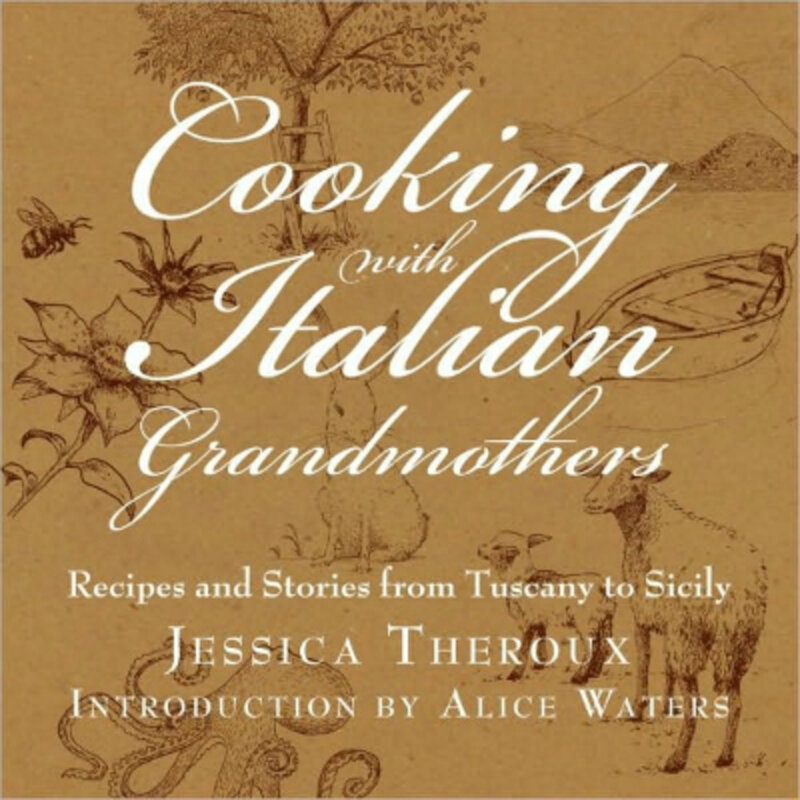Braised lamb with juniper berries
Loading...
One of the perks of doing Blue Kitchen is that we’re occasionally asked to review cookbooks. It’s also one of the drawbacks. Writing, thinking, reading and talking about food on a daily basis means that we’re almost always at least a little bit hungry – kind of a low grade infection that never clears up unless you are actually actively engaged in consuming a substantial meal at the moment. And when a gorgeous cookbook like Jessica Theroux’s comes along, whole hams can’t quite stay your hunger.
To write Cooking with Italian Grandmothers, Theroux spent a year in Italy talking, cooking and often staying with a dozen different grandmothers. Italy is the birthplace of Slow Food, a movement focusing on local, seasonal, sustainable food and preservation of traditional foods, methods and history. The beautiful, thoughtful cookbook Theroux and her army of grandmothers have created does just that.
To learn more about this amazing adventure – and about the book and chef/writer/photographer/filmmaker Theroux – read my post on the . Here, I’m going to concentrate on the recipe I adapted from the book this week. (I say this week, because I know right now that more will follow.)
Carluccia, one of Theroux’s “grandmothers,” lives in Italy’s boot tip in Calabria, maybe 60 miles from Sicily. She makes this dish with goat; I would have too, but our source for goat at the Logan Square Farmers Market was fresh out this weekend. They had lamb stew meat, though, and it was a perfect substitute.
There are many assertive flavors in this dish – lots of onion and garlic, celery, juniper berries (with their bracing gin note), fennel seed, sage (the recipe called for thyme, but I substituted the last of our fresh sage) and even a little kick from cayenne pepper. Nearly any of these elements could take on a starring role with quieter fellow ingredients, but an interesting thing happens when you throw them all together. No one ingredient stands out as something identifiable. Instead, you get a wonderfully complex, wonderfully mysterious big dish, rustic and farm table simple, but impressive enough for company. The kind of dish that will have them asking, “What’s in this?” and meaning it in a good way.
Carluccia uses another flavor-enhancing technique to add depth to the braise: She reduces the wine by half before adding it to the pot. I’d first discovered this trick in a recipe by chef Daniel Boulud, who says it makes the sauce taste as if it has cooked for days. You’ll probably notice you add water to the pot that exactly matches how much you reduce the wine. Never mind, the reduced wine will still work its magic.
(see next page for recipe)
Braised Lamb with Juniper Berries, Fennel and Sage
Serves 4
1-1/2 cups dry red wine
2 pounds lamb stew meat (or try goat – see Kitchen Notes)
salt and freshly ground black pepper
olive oil
1 medium red onion, thinly sliced (about 2-1/2 to 3 cups)
4 cloves garlic, minced
1/2 cup finely chopped celery (about 1 rib)
2 tablespoons chopped fresh sage
10 juniper berries, finely crushed with a mortar and pestle
1/2 teaspoon fennel seeds, crushed with a mortar and pestle
2 tablespoons tomato paste
water
2 bay leaves
juice of 1/2 lemon
2 tablespoons chopped Italian parsley
Preheat oven to 350 degrees F. Bring wine to boil in a sauce pan. Reduce heat and simmer until wine is reduced to 3/4 cup, about 7 to 10 minutes (if you overdo the reduction, just add unreduced wine to bring it up to 3/4 cup). Set aside. Meanwhile, pat lamb chunks dry with paper towels and season with salt and pepper. Heat a Dutch oven or other heavy oven-safe pot over medium-high heat. Add 2 tablespoons olive oil to pot; when it begins to shimmer, brown lamb chunks on all sides, working in batches. Transfer browned lamb to plate. You may need to drizzle in a little more oil between batches.
Reduce heat to medium and sauté onions with a little salt (again, you may need to add a little oil) until just softened, 5 to 7 minutes, stirring occasionally. Add garlic, celery, sage and crushed juniper berries and fennel seeds and cook for another 5 to 7 minutes.
Add wine, 3/4 cup of water, tomato paste and bay leaves and stir, scraping up browned bits. Return lamb and any accumulated juices to the pot and bring to boil. If necessary, add a little more water, but don’t make it too soupy. Remove from heat, cover with lid and place in oven. Braise for about 1-1/2 hours, until meat is almost tender.
Finish cooking on the stove top over low heat for about 1/2 hour. If sauce is too liquid, leave the lid slightly ajar so it will reduce. Conversely, if it gets too dry, add water, a little at a time. Remove from heat. Stir in lemon juice and transfer to individual plates or a serving dish. Top with chopped parsley.
Kitchen Notes
Lamb? Goat? Yes. You know how every country but the United States calls soccer football? Same deal with eating goat and lamb – it seems everyone but us does it, with gusto. In fact, 70 percent of the red meat consumed in the world is goat meat. So what does everyone else know that we don’t? Maybe it’s that goat is lighter and healthier than beef, with a slightly sweet flavor. Lamb and goat are healthier for the planet too, requiring far fewer resources to produce. Don’t get me wrong – I’m a huge fan of beef. But in this dish, it will be far too heavy tasting. Go for the lamb or the goat.
Oven or stove top? Carluccia’s recipe calls for cooking this dish on the stove top the entire time, over very low heat. But I’ve discovered that I have greater success with oven braising. The heat is gentler and more diffuse, coming at the covered pot from all sides instead of concentrating on the bottom, so the meat doesn’t dry out or turn tough. But if you’re successful with stove top braising, stick with what works.
Related post:





